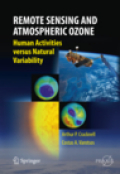
The science of global ozone change: human activities versus natural variability
Cracknell, Arthur Philip
The destruction of the ozone layer, together with global warming, is one of the hot environmental topics of today. This book examines the effect of human activities on atmospheric ozone, namely the increase of tropospheric ozone and the general diminution of stratospheric ozone and the production of the Antarctic ozone hole. Also discussed is the role of remote sensing techniques in theunderstanding of the effects of human activities on atmospheric ozone as wellas in the development of social and political awareness of the damage to the ozone layer by man-made chemicals, principally CFCs. This led to the formulation and ratification in 1989 of the Montreal Protocol on controlling/banning the manufacture and use of chemicals that damage the ozone layer. Since then, remote sensing has played a key role in monitoring atmospheric ozone concentration and determining the success of the Montreal Protocol in protecting the ozone layer from further damage. In this book, the renowned authors discuss the sophisticated instruments that have been launched into space to study not only ozone but also other trace gases in the atmosphere, some of which play a key role in the generation and destruction of ozone in the atmosphere. Professors Cracknell and Varotsos also examine the satellite-flown instruments which are involved in monitoring the absorption of solar ultraviolet light in the atmosphere in relation both to the generation and destruction of ozone and consequently to human health. This scholarly book, written by the foremost experts in thefield, looks at remote sensing and its employment in the various aspects of ozone science. It is widely acknowledged that global warming, due to anthropogenic greenhouse gases emissions, represents a threat to the sustainability of human life on Earth. However, many other threats are potentially just as serious, including atmospheric pollution, ozone depletion, water pollution, the degradation of agricultural land, deforestation, the depletion of the world's mineral resources and population growth. Explains how remote sensing provides information on atmospheric ozone related problems facing humanityProvides scientific evidence of the use of remote sensing instrumentation to monitor atmospheric ozone depletionStimulates discussion and research in the field of longer terms problems in remote sensing andozoneProvides a sound grounding in the fundamentals of current research work on atmospheric ozoneLooks at remote sensing and its employment in the various aspects of ozone scienceExamines the traditional methods of studying atmospheric ozoneDemonstrates the key role played by remote sensing in the success of the Montreal Protocol, which bans the manufacture and use of substances that damage the ozone layer INDICE: Chapter 1 The traditional measurement of ozone in the atmosphere. Chapter 2 Satellite systems for studies of atmospheric ozone. Chapter 3 The dynamics of the atmospheric ozone. Chapter 4 Observed variability of surface solar UV radiation due to total ozone variations. Chapter 5 The role of science in the social and political arguments in leading up to the Montreal Protocol toban the manufacture and use of chemical that destroy the ozone layer. Chapter6 The history of the International Ozone Commission. Chapter 7 The study of atmospheric ozone since 1987. Chapter 8 Ozone and global change.
- ISBN: 978-3-642-10333-9
- Editorial: Springer Berlin Heidelberg
- Encuadernacion: Cartoné
- Páginas: 416
- Fecha Publicación: 01/07/2011
- Nº Volúmenes: 1
- Idioma: Inglés
